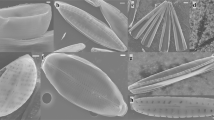Abstract
Various developmental stages (early larvae to adults) of Euphausia superba have been collected in different seasons in the Weddell Sea, the Lazarev Sea and off the Antarctic Peninsula to investigate the role of lipids and fatty acids in the life cycle of the Antarctic krill. The total-lipid data for E. superba exhibited seasonal variations, with low lipid levels in late winter/early spring and the highest levels in autumn. Seasonal changes were most pronounced in the immature and adult specimens, increasing from about 10% lipid of dry mass to more than 40%. The fatty-acid compositions of the younger stages were dominated by 20:5(n-3), 22:6(n-3) and 16:0. These are typical phospholipid fatty acids, which are major biomembrane constituents. The phospholipid composition was similar in the older stages. With increasing storage of triacylglycerols in the lipid-rich immature and adult stages, the fatty acids 14:0, 16:0 and 18:1(n-9) prevailed, comprising about 70% of total triacylglycerol fatty acids. The trophic-marker fatty acids 16:1(n-7) and 18:4(n-3), indicating phytoplankton ingestion, were less abundant. They reflected, however, the dependence of the larvae on phytoplankton as well as the seasonal changes in algal composition. The generally close linear relationships between fatty acids and lipid suggest that the fatty-acid compositions of the collected specimens were largely independent of the respective developmental stage, season and region. The linear fit indicates that triacylglycerol accumulation started at a level of about 5% of total lipid. Considering the various overwintering scenarios under discussion, the life cycle and reproductive strategies of krill are discussed in the context of the lipid metabolism and fatty-acid composition of E. superba. Lipid production is effective enough to accumulate large energy reserves for the dark season, but E. superba does not exhibit the sophisticated biosynthetic pathways known from other Antarctic euphausiids and copepods. Although important, lipid utilisation appears to be just one of several strategies of E. superba to thrive under the extreme Antarctic conditions, and this pronounced versatility may explain the success of this species in the Southern Ocean.
Similar content being viewed by others
Author information
Authors and Affiliations
Additional information
Received: 16 June 2000 / Accepted: 18 December 2000
Rights and permissions
About this article
Cite this article
Hagen, W., Kattner, G., Terbrüggen, A. et al. Lipid metabolism of the Antarctic krill Euphausia superba and its ecological implications. Marine Biology 139, 95–104 (2001). https://doi.org/10.1007/s002270000527
Issue Date:
DOI: https://doi.org/10.1007/s002270000527




